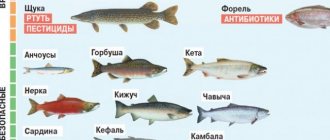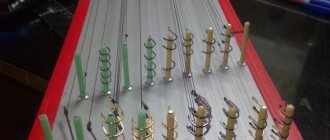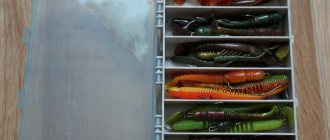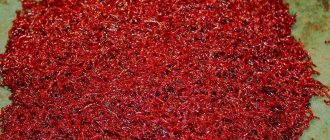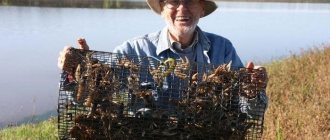Probably, there is no such person of heart who would remain indifferent to the word “crayfish”... Most will remember noisy and cheerful trips into nature, catching crayfish with nonsense or crayfish, boiling prey, eating and tasting it, and a huge, or not so, amount of beer absorbed in the process of carrying out the above activities... But, nevertheless, most of us know almost nothing about the lifestyle, habitat, and, let’s be honest, the reproduction of these invertebrates that we so dearly love. And this is greatly facilitated by the fact that crayfish become active at dusk, and in the case of cloudy weather - after lunch, towards evening.
Getting to know crayfish
The crayfish's forelimbs (claws) are very developed. It uses them exclusively to attack its prey and for defense.
Crayfish live only in clean water, not contaminated with metals and other chemical elements. Another distinctive feature is that crayfish only need fresh water; they do not live in anything else. Theoretically, crayfish live in places with a hard bottom. But in practice they can also be found in muddy bodies of water. Crayfish live at a depth of 0.7 -3 m. The best places are captured by males, leaving worse places for young animals and females. (As you can see, in the animal world everything is exactly like in humans).
There is an opinion that crayfish lead a sedentary lifestyle. That is, they move no more than 10 m from their burrow in search of food. But in practice, they can migrate throughout the entire reservoir without staying in one sector for more than 2-3 days.
Read: Catching black croaker
Crayfish grow very slowly. The rate directly depends on various factors - water temperature, depth of the reservoir, density of crayfish, as well as the presence of food supply and predators. On average, one-year-olds reach a size of 1.5-2 cm, two-year-olds up to 5 cm, three-year-olds up to 6.5 cm. As you can see, it will take 7 years for the crayfish to grow to the size allowed for catching (which is 10 cm).
Cancer is an omnivore. At a young age, it feeds on aquatic vegetation, but as it grows, it also includes animal food, such as mosquito larvae, plankton, and water fleas, in its diet.
The cancer eats its prey, holding it with its claws and tearing off piece by piece with the sharp parts of its mouth.
Cancer has many enemies. These are burbot, perch, pike, which eat crayfish during molting, and, of course, eel, whose body structure allows it to easily climb into the hole of a molting crayfish. The latter, by the way, is the worst enemy of crayfish. In addition to these predators, mink and muskrat pose a great danger to crayfish.
But still, the greatest damage to the crayfish population is caused by the disease – crayfish plague.
The causative agent of this disease is the fungus Aphanomyces astaci. It was originally discovered in northern Italy. Initially, it was mistakenly believed that the disease was caused by bacteria, and only after 1930 was it possible to identify the causative agent of the disease. A cancer patient is lethargic, walks staggering, and his defense reflex disappears.
The nuances of catching crayfish by season
Catching crayfish depends on the water temperature.
If the beginning of summer is warm enough, then you can start fishing in May-June. If the summer is cold, then the molting of crayfish is delayed and you need to start catching them no earlier than mid-July.
From the second half of September, the meat of the animal loses its taste and quality, and the catch is noticeably reduced. By this time the shell becomes too hard and they are in less demand.
In autumn, when frosts are possible at night, and during the day the temperature warms up the surface of the water shallowly, closer to night the crayfish crawl towards the shore into warmer waters. In the autumn season, crayfish fishing continues until the freeze-up.
In summer, it is also easier to catch crayfish at night, when they come out of their hiding places to find food. The best time for this is from 10 pm to 3 am. Sometimes animals come out even before dawn.
Methods of catching crayfish
Active fishing for crayfish begins after the water has sufficiently warmed up, facilitating the speedy completion of molting. In central Russia, this period occurs at the end of June, beginning of July (depending on weather conditions). The main method of catching crayfish is to install meshes (crayfish), which can be of a wide variety of shapes and designs.
Read: Sea kelp from... Belarus
• Catching crayfish with your hands. This is the simplest and least expensive method of fishing, in which the catcher, moving in the water, examines the possible habitats of crayfish and, noticing them, collects them with his hands. The disadvantage of this method is the presence of claws in crayfish. As a countermeasure, you can use gloves or a net. Catching crayfish by hand requires skill and a certain amount of courage.
• A more advanced method is to fish with a rod and bait. With this method, bait (rotten meat or fried pulp of a toothless shell) is tied to a stick 1-2.5 m long and thrown into the water. It remains to wait a while. Then slowly remove the bait, and catch the crayfish with your hands or a net. There is no point in placing fishing rods more often than 5-6 m from each other.
• Much more effective, compared to previous methods, is fishing with crayfish traps (racni), which are a mesh stretched over a metal hoop and a bait attached in the middle. Previously, tree branches were used instead of a hoop, forming a ring from them. Using three or four cords tied at equal distances from each other, the crayfish catcher is centered to avoid distortions. Afterwards, the cords are combined into one and attached to a stronger rope that can withstand the total weight of the crayfish and the caught crayfish. If the ravine is cast at a sufficient distance from the shore, a stick is attached to the rope. As a modification of this design, an option should be considered in which an additional hoop is attached to the top of the crayfish at a distance of several centimeters, preventing the crayfish from escaping when lifted.
Read: Fishing for halibut from a boat. Subtleties of plumb fishing
• To catch crayfish, large nets are also used, which are dragged along the bottom from the shore or boat. The bottom must be flat, without stones and branches, otherwise it is easy to tear the mesh.
• But, of course, the most convenient in terms of catching crayfish are the meshes. Merezhi is a frame made of wire, covered with a net and mounted in such a way that once the crayfish get inside, they cannot escape to freedom. Experienced fishermen set dozens, even hundreds of lines. There are a lot of mesh designs, let’s just say that they are divided into horizontal and vertical.
How to get crayfish?
crayfish as inhabitants of domestic water bodies , since everyone knows about them. Everyone knows that someone has become “red as a lobster” or “backs away like a lobster.” The only thing that needs to be added is that crayfish crawl head first and swim backwards, scooping up water with a powerful tail plate.
Cancer competitors
Crayfish live in both the European and Asian parts of Russia . They are not very numerous, since by the end of the 19th century they became a popular food, and at the beginning of the 20th century, their ranks were struck by the crayfish plague. At the same time, in Europe, the indigenous inhabitant of water bodies - the broad-toed crayfish - was replaced by the American signal crayfish imported from the New World.
The advantages of the overseas crayfish are obvious: the broad-toed crayfish can only live in running, clean water, while its American competitor survives in dirty water. In addition, the American crayfish does not suffer from the crayfish plague. So the prospects for the broad-clawed crayfish are questionable.
To catch crayfish, you need to go to rivers with clean running water, and not to lakes, where the water can be stagnant and polluted, which crayfish cannot tolerate. It is better to choose a river with a rocky bottom, where crayfish can find shelter, or with a clay bottom, in which they dig holes for themselves under the bank.
Crayfish go hunting at night, so the best time to catch them is from ten in the evening to three in the morning. If you want to catch a fatty, tasty specimen with tender meat, then it is better to do this in early autumn.
Prohibitions for protection
It should be remembered that there are a lot of restrictions and prohibitions on catching crayfish due to their small numbers, and in different areas with different deadlines. So, in the Moscow region, catching crayfish is generally prohibited. In the Astrakhan region - from April 1 to June 30, in the Kursk region - from October 1 to June 30, in the Novgorod region - from May 25 to June 30. In addition, there are restrictions on the size of crayfish, a ban on catching pregnant females, on the number and design of crayfish, etc.
But despite this, there is a lot of time left for catching crayfish, and let’s now see how to actually catch crayfish.
These arthropods are caught either using special crayfish traps or simply by hand. But before you go fishing, you need to take care of the bait. Crayfish are best served in a dish prepared according to the following recipe: add a little dill, cake, and a piece of black bread, the crust of which has been rubbed with garlic, to fresh fish. Prepare this appetizer and your cancer will be yours.
But let's return to fishing methods . The shells come in open and closed types. They differ in design features and, therefore, in functioning and price. If an open-type clamshell is easy to make yourself, then a closed-type clamshell is more complex in design. But if the open tackle needs to be checked every 15-29 minutes, then you can look into the closed one 2-3 times a night because the crayfish caught in such a trap has nowhere to run.
You can catch crayfish with your hands . At night, light a fire on the shore; the bright light attracts crayfish so much that they even crawl onto land. During the day you can collect crayfish in shallow water and pull them out of their holes. When caught, use gloves, because the caught crayfish actively resists.
If he still grabs your hand, do not tear him by force, try other methods. Experienced fishermen advise not to panic in such cases, but to remain calm and act cunningly. Pour water into a bag and place the crayfish in it. He will feel freedom, try to escape, and of course free your hand. You can also press on the inside of the claw with your finger - the cancer will have to let you go.
Photo: yoou.ru
How to catch crayfish at night with a flashlight
Crabs, lobsters, lobsters - all these arthropods serve as a delicacy in our area. Far from the seas and oceans, we have to be content with crayfish that are found in our rivers and lakes. Anyone who has tried crayfish meat at least once understands why there are so many people who want to hunt them. By the way, crayfish play an important role in cleaning water bodies by eating the remains of other inhabitants of the underwater world. So in some areas they strictly monitor the number of crayfish caught - for example, it is allowed to take no more than three dozen, and catching them during the period of mating and bearing offspring is prohibited.
How to catch crayfish at night
Crayfish are caught in the morning, and in most cases in the late evening and at night. It is during this period that crustaceans go out hunting, having become hungry in a daytime ambush. But for night fishing, not all methods are considered effective, for example, diving with a mask and others. At night, crayfish fishermen actively use the crayfish’s natural “craving” for the light… of a fire. Catching crayfish using this “light-manual” method comes down to the fact that the crayfish that crawled out into the light of a bright fire can only be collected by hand. But at the same time you need to act extremely carefully: you need to take the crayfish by the tail part, the abdomen, so as not to give it the opportunity to defend itself with its claws. In addition, everyone remembers that crayfish move quickly and backwards in the water, so any noise and unnecessary movement in front of the crayfish will make it run away with a sharp movement. Moreover, in one movement of the abdomen, the cancer will move away from you at a distance of up to 20 centimeters. For beginning crayfish fishermen, it is recommended to use gloves. If luck is on the side of the crayfish, then the crayfish will crawl out to them right on the shore - here a fish tank and a small stick will come to the rescue. Many people use flashlights instead of a fire to attract crayfish to the shore. This method is quite effective, but is considered prohibited in many areas.
Catching crayfish using a crayfish
In the darkness and silence of the night, special devices for crayfish are often used - crayfish traps or crayfish traps. The design of the shell is not very complicated and it is not difficult to make it yourself. You need to take a strong wire and bend it into the shape of a ring (diameter about 30–50 centimeters). A nylon mesh is stretched over a fixed hoop (some craftsmen use women's stockings for this purpose) - something like a net is obtained. Additionally, 4 cords are attached to the rim, and their ends are connected together. Subsequently, with the help of these cords connected at the top, the crayfish catcher is fixed on any stick, and the rim itself is lowered into the water. In order to mark a crayfish trap without using a stick, use a piece of foam plastic, to which the ends of the laces collected together are tied - you get an improvised float. For greater efficiency, several such traps are used simultaneously. And you won’t be able to get enough sleep—the shells need to be checked every 20–30 minutes.
Naturally, to attract crayfish into the trap, various baits of animal origin are used: pieces of fish, parts of frogs (without skin), snails. Crayfish have an excellent sense of smell, so the bait can be cut and even turned inside out. But at the same time, it is imperative to maintain its elasticity and prevent the bait from falling apart. One more point: experienced crayfishers have noticed that crayfish “peck” at bait caught in their own body of water, and they ignore prey brought from foreign rivers and lakes. Just like they don’t really welcome predatory fish as bait.
Catching crayfish with a fishing rod video
Despite all the paradox and low probability, catching crayfish with a fishing rod also has the right to happen. Moreover, many avid fishermen (and fishing experience is measured in years) can share stories like “I’m getting ready to go home to grab my fishing rod, and there’s a crayfish. Yes what! And so on, and only the truth. And in fact, it happens that if the crayfish does not “catch” the hook, it may well catch the fishing line with its claws. The rod for catching crayfish is much simpler than usual: a simple pointed stick with a bait at the end (you can use the same nylon stocking). The stick is inserted into the coastal bottom, and when it moves, the most smooth movements will be required so that the crayfish does not come off. If you use a classic fishing rod with a line and a hook (for fishing at depth), then the hook should be the smallest (No. 2.5–3), and the area around it should be baited. But in any case, this method is the most unsuccessful: the crayfish “bites” extremely inactively and you need to have great patience, and besides, there is a high probability that it will bite the fishing line.
And finally. Catching crayfish is not an easy task and sometimes very unproductive, that is, rarely can anyone catch more than 3-4 pieces the first time. But you can enjoy even a small catch by boiling the crayfish in well-salted water with the addition of dill. Despite the small amount of edible meat: the abdomen is the so-called crayfish neck, and a little in the claws and legs. Many crayfish fishermen return to this fishery again and again with pleasure. Due to the fact that crayfish meat is very popular in many city restaurants, many make a kind of business out of it, breeding crayfish at home and selling them to restaurateurs. You can read how to breed crayfish yourself for sale here.
How to catch crayfish video
hozyindachi.ru
Description of the species
To make it easier to catch a cancer, you need to become at least a little familiar with its lifestyle and habits. So let's start, crayfish belongs to the order of crustaceans. The forelimbs of these animals have claws, which they use to protect themselves from enemies and obtain food.
| Crayfish with eggs |
They move with the help of the other four pairs of limbs. It is easy to determine the sex of an adult crayfish by its claws - as a rule, in males they are larger and more massive than in females.
| Crayfish live exclusively in fresh waters. |
Crayfish do not reproduce well in polluted waters and are not found at all in rivers and ponds with a muddy bottom. Cancer prefers a rocky bottom and lives at a depth of up to three meters.
Crustaceans lead a “hermit” lifestyle. Each has its own hole or other shelter, which it jealously guards from outsiders. During the day he stays there, and, sensing danger, he hides deeper in the hole. It is quite difficult to get the crayfish out of there, as it clings to the walls with its claws.
With the onset of dusk, crayfish come out of their shelters in search of food. They are omnivores, but their main diet consists of plant foods. Crayfish also eat plankton, insect larvae, snails, bottom organisms, and sometimes their relatives.
It takes crayfish several years to grow to the minimum size allowed for fishing (10 centimeters in length). Males reach these parameters in the sixth year of life, females in the eighth. There is no reliable information about the lifespan of these animals, but in various sources there were references to twenty-year-old individuals.
Crayfish mate in the autumn season (September-October). The eggs laid by the female after mating remain under her tail until July, then the larvae hatch from them and after a few days begin to live independently.
Although crayfish has protection in the form of a powerful shell, it can become prey for many fish and mammals. The most dangerous for crayfish is the eel, which can easily penetrate their burrows. It is better for young animals to avoid encounters with perch, and for larvae - with bream. As for mammals, among them the worst enemies of crayfish are minks and muskrats.
But most of these animals are not killed by predators. They are also destroyed by a disease called “crayfish plague”.

